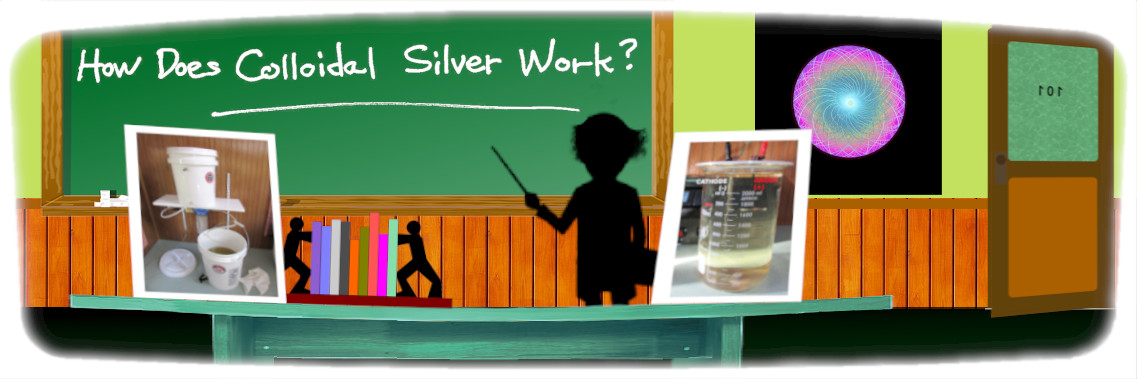How Does Colloidal Silver Work?

Colloidal silver has been good news for many people. Many Purevon patrons have had such success that they are often having bottles sent to their family and friends. Silver is used because of its anti-bacterial property; and is needed now, more than ever, as an alternative to, or as a helper for use in conjunction with antibiotic medications. Bacteria can adapt to resist antibiotics; so, over time, the drugs that worked for our parents and grand-parents may no-longer work for us.1
Important Definition |
Ion ― an atom or group of atoms that carries a positive or negative electric charge as a result of having lost or gained one or more electrons.2 |
So, how does colloidal silver work? Does silver just have an inherent lethal effect on bacteria? Yes, it does; and that’s why real silver silverware is self-sterilizing. Silver is inert until it is activated by gasses in the air, or by an electrolytic process used when making colloidal silver. When silverware tarnishes, a tiny amount of the silver has separated away and reacted with the air. The silver at the surface where it is exposed to air, takes on an electric charge, albeit very small; thereby becoming ionized. The ionized form of silver can be biologically active; “Physiologically, it exists as an ion in the body. In each case, the antimicrobial properties of silver are dependent upon release of biologically active silver ion (Ag*) from metallic silver”3
“Four main mechanisms of action of silver ions” have been studied:
“Destabilization of the cell membrane through the binding of silver ions to the sulfur atoms present in sulfhydryl groups of proteins and enzymes located on the bacterial cell surface.” [This is about the destruction of disease-causing bacteria by demolishing their cell membranes.]
“Production of reactive oxygen species (ROS).” Reactive oxygen species (ROS) “...Are not uniformly defined... In a biological context, ROS are byproducts of the normal metabolism of oxygen. ROS have roles in cell signaling and homeostasis. ROS are intrinsic to cellular functioning, and are present at low and stationary levels in normal cells.”4
“Inhibition of metabolic pathways through the binding of silver ions to any protein that has some sulfur atom function... This suspension of submicroscopic silver particles does not attack the bacteria directly, but causes a deactivation of enzymes responsible for their respiration, multiplication, and metabolism.”
“Interaction with bacterial DNA which causes the breakdown of cell cycle.”
Important Definition |
The oligodynamic effect ― (from Greek oligos, "few", and dynamis, "force") is a biocidal effect of metals, especially heavy metals, that occurs even in low concentrations.5 |
“One of the main characteristics of silver is its oligodynamic effect, which is defined as the high microbicidal capacity of silver ions in water at a very low concentration (one part per million).” The oligodynamic effect makes colloidal silver safe and effective because the amount of silver needed to kill germs is so little that it has no toxic effect on the patient. The silver is both colloidal and ionic at the same time; colloidal because its particle size is smaller than 1 micron in diameter; ionic because it is carrying an electric charge. The electric charge is responsible for keeping the particles of silver in colloidal suspension in the water, because of the charge’s repelling force among the particles. The repulsive force overcomes gravity by preventing the silver particles from clustering together and settling to the bottom of the container.
“The mass of colloidal sol particles is so minute that the objectionable effect of intense reactions on the human subject are largely avoided, whilst the advantages of rapid and complete reaction are secured. For this reason, certain medicines administered in the colloidal form are not merely more active and possess greater penetrating power, but they are free from the poisonous effect of the same substances when given in the form of tincture or solution.”6
1 Antibacterial Activity of Colloidal Silver against Gram-Negative and Gram-Positive Bacteria, by Andrea Vila Domínguez, Rafael Ayerbe Algaba, Andrea Miró Canturri, Ángel Rodríguez Villodres and Younes Smani, Antibiotics (Journal), Jan. 19, 2020
3 National Center for Biotechnology Information (2023). PubChem Compound Summary for CID 104755, Silver cation. Retrieved October 25, 2023 from Pubchem.
6 The Use of Colloids in Health and Disease, Alfred B. Searle, London, Constable and Company, Ltd., 1920, pp. 3 - 20.
